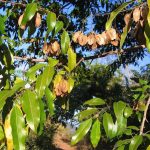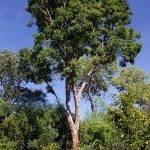TREE LIFE
April 1998
The annual subs ($60) are now due. Please use the invoice attached to your February Tree Life when paying and indicate if your address has changed.
Stop Press! Anthon Ellert, Chairman of the Bulawayo Branch is planning a trip to the botanically exciting Buchwa Mountain and Nyoni Hills in August. This entails advance planning so if you think you would like to be on that trip please contact Anthon in Bulawayo at home on 46586 or during office hours on 540581 as soon as possible so that an assessment of the size of the group can be made and plans set in motion.
MASHONALAND CALENDAR
Tuesday 7th April. Botanic Garden Walk. This month Tom continues the series on some of the lowveld trees. We will meet Tom in the car park at 4.45 for 5.00 p.m. and there will be a guard for the cars.
Sunday 19th April. Having spent many of Mark’s Walks at Lyndhurst farm, and each time wishing that we had time to wander further along the river, we have arranged with the Schots family to spend the whole day at the farm. This is an excellent spot for revision of some of the Highveld trees.
Saturday 25th April. Mark’s Walk will be at Domboshawa again to have a close look at some of the seepage zone species. On our previous visit the entrance fee was still $3. We meet at 2.30 p.m.
Tuesday 5th May. Botanic Garden Walk.
NOTICE OF ANNUAL GENERAL MEETING
Notice is hereby given that the 48th Annual General Meeting of the Tree Society of Zimbabwe will be held on Sunday 17th May 1998 at Christon Bank Botanic Garden Extension.
AGENDA
1. Notice convening the meeting.
2. Apologies.
3. Minutes of the 47th A.G.M.
4. Matters Arising.
5. Chairman’s Report.
6. Treasurers Report.
7. Election of Committee Members.
8. Any Other Business.
Any proposals/resolutions and nominations for office bearers should be forwarded to P 0 Box 2128, Harare by Monday 11th May if possible, although proposals and nominations will be accepted from the floor.
MATABELELAND CALENDAR
Sunday 5th April. An all day trip to Double Cross Ranch, Gwanda. With luck we will find Erythrophysa transvaalensis last found here 27 years ago. Bring lunch, drinks and chairs etc. Make sure your car has a full tank of fuel. Meet at Girls’ College at 8 for 8.30 a.m.
Wednesday 8th April. The next episode of The Private Life of Plants at Girls’ College at 7:30 for 8 p.m. Please use the Pauling Road entrance where the security guard will admit your car.
Sunday 3rd May. A walk led by Tessa Ball followed by a brief A.G.M.
NYANGA January 1998
On Sat 24th January I joined about 12 other members of the Tree Society in exploring the flora on the top of Rukotso, the second highest mountain in Zimbabwe at 2404 metres, which at this time of year is covered with a fascinating array of wild flowers. Much against my will (as I am very ignorant in this regard) Andy managed to coerce me into doing the write up on the day. So, if this is not very interesting, please blame Andy.
We set off up the mountain at about 8.45. The weather was not promising, with swirling mists and rain. However it was still magnificently beautiful and by the time we made our first stop to have a look at some lovely grey leafed Vernonia natalensis (Asteraceae) with its pretty blue shaving brush flowers, we had all forgotten to be worried about the weather. We also had our first close look at a delightful plant that formed carpets of small white flowers in the shallow pockets of soil on the sheet rock. This was Craterostigma lanceolatum (Scrophulariaceae) and was found all over the mountain, alongside the small pink Oxalis semiloba (Oxalidaceae) and the bright blue powder puff flowers of a Cyanotis (Commelinaceae) which had each of the six stamens tipped with bright golden anthers.
There we saw a group of eye-catching orchids, the lovely purple Disa versicolor. These small ground orchids can vary in colour from cerise pink through purple to red and were very common all over the mountain often occurring in quite large groups. Mark Hyde explained that the Disa flowers have a single spur formed by the hooded dorsal sepal thus differing from the Satyrium that have twin spurs.
We then drove on up to the tower where we parked our cars arid explored the surrounding area before moving up to the beacon. We immediately came across a small geranium. Some plants had white flowers while others had pink. We had a long discussion as to whether these were two different species but eventually decided that it was Geranium nyassense whose flowers do vary from white to pale pink. This was also common and very pretty. Again Mark told us that the difference between the genera Geranium and Pelargonium is that geraniums have a symmetrical petal form (asymmetric in Pelargonium) while true Pelargonium have a backwardly-directed spur fused tightly to the pedicel. Both genera are found up at Rukotso and we were hoping to find the Pelargonium but as far as I know no one came across any.
Three flowers that remain in my memory are a yellow Bulbine (Liliaceae) a bright pink Dierama (Iridaceae) maybe Dierama inyangense and a bright purply blue Moraea (Iridaceae). These were all fairly conspicuous. Bob Drummond identified two of Mark’s specimens as Bulbine abyssinica and the Eastern Districts’ Bulbine latifolia. We were all puzzled about another dainty little Iridaceae with bright pink flowers with a dark red stripe on each of the three lower petals. We couldn’t decide whether this was a Hesperantha or Radinosiphon leptostachya, but Bob later identified it as the latter. All of these were found higher up among the rocky outcrops.
Two yellow flowering Asteraceae worth mentioning are Helichrysum umbraculigerum with its distinctive umbrella shaped flower head and a strongly aromatic species of Schistostephium. We also saw a lemony scented species of Satureja (possibly now in the genus Micromeria), which is covered in shiny glands like so many Nyanga plants.
Interesting foliage plants found higher up among the rocks included the spiky silver Stoebe vulgaris, Euphorbia cyparissioides with the leaves in a crowded mass all up the stem, a stumpy bonsai looking Crassula, namely Crassula sarcocaulon, a red-leaved Clutia and a red-stemmed Anthospermum (Anthospermum ammannioides?). I am sure landscape designers would go wild about them.
A very showy Indigofera dendroides with conspicuous spikes of pinky red flowers caught the eye while the tiny red flowered Indigofera Iongipedicellata although not so showy was nevertheless very pretty.
Mark found an interesting rare E. District high altitude grass species that had been identified by Bob as Merxmuellera disticha.
I think the only fern that we took any notice of was the Elaphoglossum aubertii with its spade shaped fertile lamina covered in spore, which was growing amongst the rocks. There we also came across some small Streptocarpus under the rocks but were not sure of their identity.
Once we got up to the top Andy pointed out the different aloes: Aloe inyangensis, which was in flower, Aloe arborescens, Aloe cameronii and Aloe greatheadii. At the summit we saw Curtisia dentata, Myrsine africana and two species of Rhus, namely
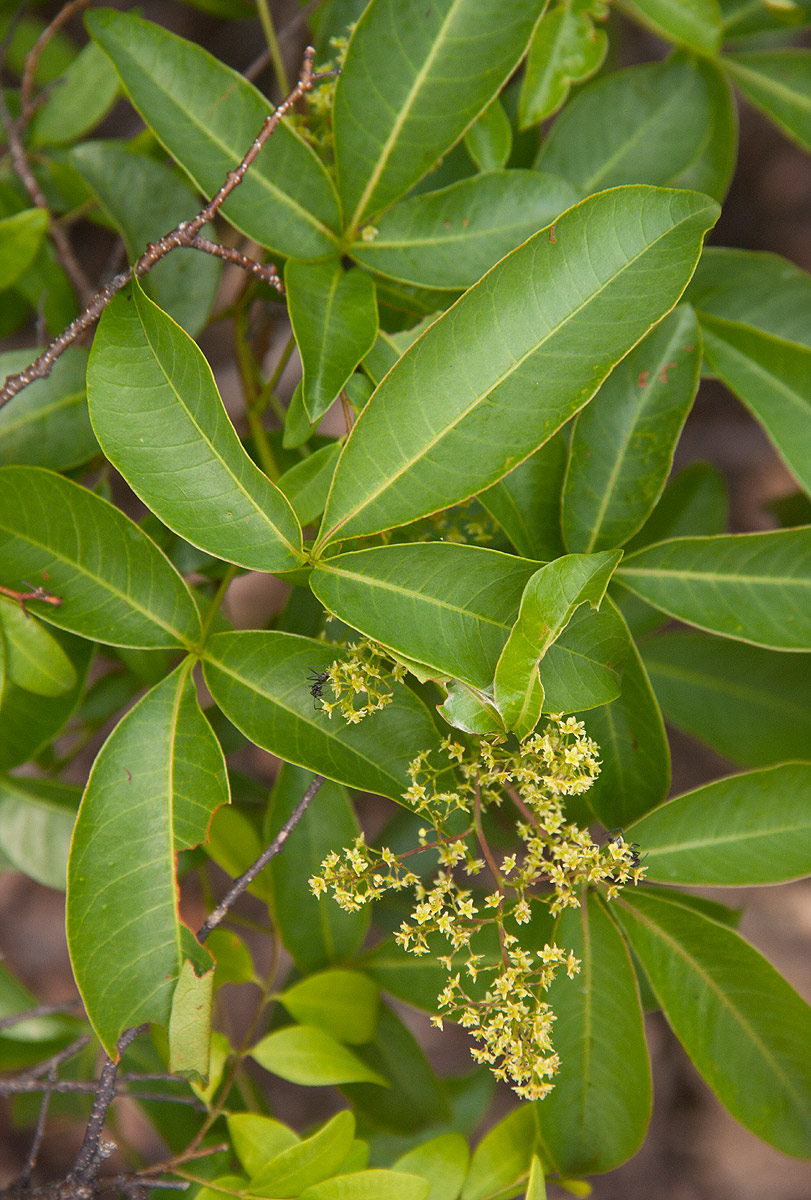
Rhus chirindensis. Photo: Bart Wursten. Source: Flora of Zimbabwe
Rhus chirindensis and Rhus lucida. Other orchids that we found were a lovely cream and greeny flowered Habenaria, Satyrium longicauda and the rather unusual looking Schizochilus cecilii with its tiny pale yellow flowers spiralling around a nodding stem. There were masses of these down on the flatter ground.
Other flowers that should not be left out include; Alepidea swynnertonii, Wahlenbergia undulata, Hypoxis obtusa, Sopubia mannii, Zaluzianskya tropicalis, a tiny purple Polygala, Clematopsis vilosa, Vigna nervosa, a species of Aeschynomene, Pentas purpurea, a scabious Ranunculus multifidus, Eucomis, Chlorophytum, Kniphofia and specimens from two Cape genera: Euryops transvaalensis ssp. setilobus and Ursinia montana.
After a picnic lunch we wandered over to the magnificent view and sat resting and talking, our minds thoroughly glutted with the Latin names and sights and smells of all the wonderful species of Nyanga wild flowers we had seen. We made our way back to the cars just in time before the rain finally came pouring down.
-D. de Swardt.
Sunday 25 January allowed a party of 8 Society members to rise from the hands and knees posture used to look at flowers on Saturday and regain the upright habit of humans in order to examine the trees in communal lands north of Nyanga.
An hours travel from Ezulweni “the place of God” in Zulu, and a descent of ±800 metres from our accommodation, brought us to another fruitful site, on one side of the road a stream in full and muddy spate, and on the other a steep hillside.
Parking the cars in the shade of
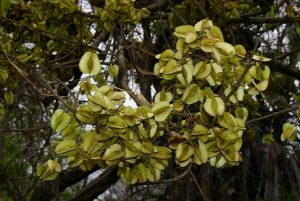
Combretum adenogonium. Photo: Bart Wursten. Source: Flora of Zimbabwe.
Combretum adenogonium, its leaves 3- or 4-whorled, the party chose the stream for its first walk.
Antidesma venosum, with their greenish yellow berries on drooping spikes, and Senna petersiana, in flower and with their characteristic kidney shaped stipules and orange tipped glands were plentiful.
The stream bank itself was noteworthy for Syzygium cordatum and Breonadia salicina. Together their exposed roots seemed to be all that there was to prevent the complete erosion of the river course by the flood. The former was sometimes stunted but there were large specimens of the Breonadia and they were in flower with compact round axillary heads, pale yellow and tinged with red. To distinguish Breonadia from the very similar Rauvolfia caffra test for the milky latex and leaves with translucent veins characteristic of the latter.
Walking downstream we came across an interesting clump centred on a Ficus glumosa, its roots spread out over a slab of sedimentary rock and with its branchlets densely covered with yellowish brown hairs. Round it were Euphorbia cooperi, its paired thorns borne on a continuous horny strip and conveniently close to the stream for its use as a fish poison, Sterculia africana, Strychnos madagascariensis, with its sturdy side shoots and leaves clustered towards the end of the twigs, Olax dissitiflora with its lazy drooping branches and leaves folded upwards, and Rhoicissus revoilii.
Two Garcinia species were seen during the day, the first appropriately for the rocky environment we were in, the evergreen granite Garcinia buchananii with its thick sticky and yellow latex. The wood too is said to be yellow.
Among the non-tree finds of interest on this side of the road was the herb Tacca sp., the succulent Heurnia sp., its foul smelling flower pollinated by flies, and the amber coloured rock which was a puzzle to everyone.
When attention switched to the hillside the first interesting find of the day was made. Among the Friesodielsia obovata, Stereospermum kunthianum, Euclea divinorum and Euclea racemosa, Steganotaenia araliacea and Holarrhena pubescens (briefly mistaken for Tabernaemontana elegans by some of us) Mark found Dorstenia sp. a herbaceous member of the fig family.
Several Annona senegalensis were found with their large bluish-green leaves. Unfortunately none had fruit, reputed to have a very pleasant flavour. If you are lucky enough to find them and they are still green, pick them but leave them in a dark warm place to ripen.
Also without fruit was
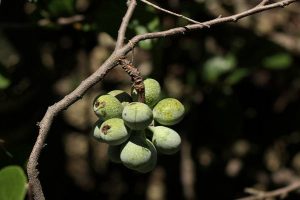
Artabotrys brachypetalus. Photo B.T. Wursten. Source: Flora of Zimbabwe.
Artabotrys brachypetalus, which climbs using its hooked inflorescence stalks. Later in the day we found another specimen with the clusters of the skittle shaped purplish black fruits. They are said to be edible but we found the flavour to be unpleasant.
At midday the party continued its journey northwards, destination the Nyangombe River bridge in St Swithin’s Communal land.
At Ruangwe business centre there was no petrol at the garage (“Try Nyamapanda”!) but we were rewarded with a large specimen of Entada abyssinica, acacia-like but unarmed. When its large pods are dry, each seed with its own segment can be pressed out from the hard woody rim. There was an interesting row of Calotropis procera an exotic with milky latex and a large inflated, fibrous pod.
Leaving the tar, we now enjoyed a 40-kilometre drive to the river in hilly country with lovely valleys with many examples of ancient terracing.
Soon after the lunch stop we saw the second Garcinia of the day, named after Livingstone, its rigid branches rising at a steep angle from the trunk (Garcinia livingstonei).
Passing an abandoned refugee camp on the east bank the party parked just inside the Chairman’s jurisdiction on the far side of the bridge.
Two interesting finds were made, a Clematis-¬like climber Caucanthus auriculatus and something with Annona-like fruits – Monodora junodii.
At 4.30 we left for home and by nightfall we were climbing into the clouds and drizzle of the highlands again. At 7:00 p.m. we had reached our accommodation, thankful to have missed a black cow standing sideways on in the darkness.
-A. MacFarlane
ACACIA & SENTINEL, OR THE ELUSIVE LAETA
For those of us living in Matabeleland or in the lowveld, acacias are an important component of the landscape – memorable not just to the eye but also, sometimes, to the skin. Oh, those poor folk in Mashonaland deprived of Acacias with just mile upon mile of Msasa!
But as a group, acacias have always given problems. Some are readily identified, for example (Faidherbia) Acacia albida and Acacia nigrescens, but others can be the subjects of endless discussion. This can often end up with the unanswered question – what is a species, other than what a taxonomist decided. But is the taxonomist right?
Although the real draw of the recent Matabeleland Branch trip to Sentinel Ranch, 60km west of Beitbridge along the Limpopo River, were the wonderful Cretaceous Sandstone outcrops and cliffs that rise above the broad strip of alluvium, and the host of unusual plants found there, the other objective was to look at Acacias. Sentinel, the adjacent Nottingham Estates (one of Zimbabwe’s largest irrigated citrus farms) and Maramani communal land, which stretches up to the Tuli Circle, forms one of the most botanically interesting areas in the country. Other botanical treasures will be described elsewhere – I will restrict myself to the acacias.
Chris Fagg and Richard Barnes, of the Oxford Forestry Institute in UK, and myself are in the final stages of producing a detailed, illustrated field guide to the Acacias of Zimbabwe – a guide designed for the interested layman. An important feature is that people should be able to identity almost any specimen from vegetative material only, without recourse to flower, pods or tape measure, unless absolutely necessary. Various members of the Tree Society have already commented on a draft, for which we are very grateful. But we had had, until recently, very little feedback on the main key.
Thus Matabeleland members, joined by Bob Drummond and Edward Wilson from Harare, were subjected to trial by acacia over a long weekend. Ian McCausland had incessant acacia talk for even longer, as some of us made a full week of it. Various “unknown” species were distributed, or individuals pointed out in the field, and people asked to identify them just using the dichotomous key – a very interesting exercise that shows clearly how some of us make far too many assumptions. For example, what really is “grey-green”, how hairy is “pubescent”, and what do “large” and “small” mean? In addition, there are all the problems of having species with number of pinnae pairs differing from the norm, of deciding if a specimen is 2-3 pinnae pairs, or 3-4, and separating “small scattered red glands” from specks of dust. Although numerous problems arose, and some were a little upset that they came out to what was in fact the wrong species, much was learnt. If a key doesn’t work it is usually the fault of the author, not the user. And Chris is now busy deciphering his pages of notes to try and make it better. At least the new revision will be “tried and tested”, if not guaranteed to work everywhere, every time.
Sentinel is full of Acacia; we recorded at least 17 species. The areas of greatest interest were the clayey alluvial flats, some probably almost impassable in the rains. The calcium-rich nature of the soils was indicated by the frequency of white calcium nodules lying over the surface. Many Acacia require reason¬able levels of calcium to establish themselves, hence the relatively low number in nutrient-poor high rainfall areas.
Here we found Acacia nebrownii, Acacia senegal var. rostrata and var. leiorhachis, Acacia tortilis subsp. heteracantha, Acacia grandicornuta, Acacia mellifera and the elusive Acacia laeta (of which more later). A real special here was
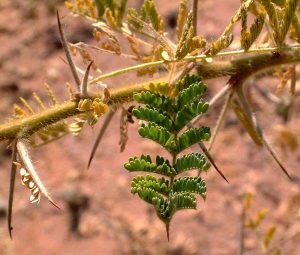
Acacia stuhlmannii. Photo: R. Burrett. Source: Flora of Zimbabwe.
Acacia stuhlmannii, a 2m spreading shrub covered in long shaggy yellowish hairs, seemingly restricted to certain drainage lines. Within Zimbabwe it is known from Nottingham Estates and from populations along the Bulawayo road near Beitbridge, but this was the first record from Sentinel. The species is also known from a few restricted populations in Botswana (Nata River, Tuli Block) and just over the border in parts of the former northern Transvaal. The surprising thing is that where it occurs it is locally dominant, and then abruptly stops. The population along the Bulawayo-Beitbridge road is still healthy despite heavy goat browsing almost 30 years after first being collected there. The other, more surprising, feature is that the nearest other populations are in northern Tanzania, Kenya and Somalia. There are many interesting biogeographical questions raised by such disjunctive distributions – questions mirrored also in other Acacia species.
Acacia nebrownii, a slender-stemmed bush, was readily recognised from a distance. The confusing Acacia grandicornuta with its oft-inflated thorns was coming into flower – white globose inflorescences which seem to blend into the grey-green foliage, but are certainly noticed by masses of pollinating insects. It was this species that has given us some embarrassment. On a previous trip to Gonarezhou, Chris and I were glibly recording its occurrence in drainage lines – but this, in retrospect, is more likely to have been Acacia robusta subsp. clavigera. Tom Muller says that this complex (Acacia robusta – Acacia grandicornuta) has given him more trouble than any other, so we can be forgiven.
A surprising find was Acacia erioloba, some 250km south of its previous southern occurrence in western Zimbabwe (Umgusa Valley), and a similar distance southeast of the couple of occurrences in northern Gonarezhou. It is, of course, found closer than that over the border in Botswana and South Africa, but still at least 50km away. What a strange sight – a few reasonable-sized and mature trees of Acacia erioloba mixed up with mopane on a small ridge of deep sand. Just the sort of country for barking geckoes, too!
But the main species we had come to find was Acacia laeta. Chris and I had found an aberrant Acacia mellifera on passing through Sentinel two years previously – an individual that had one, two or three downward pointing hooked prickles, and more pairs of pinnae than normal (Acacia mellifera always has only two prickles). Chris immediately recognised the possibility that it may be a species called Acacia laeta, only known from tropical West Africa across to northern Tanzania. This “species” has been more-or-less proved to be a hybrid Acacia mellifera and Acacia senegal. We assumed that as both Acacia mellifera and Acacia senegal var. rostrata occurred in the vicinity it could have arisen here. The feature of Acacia laeta that makes it more than just an ordinary hybrid is that it is fertile, thus can lead a reproductive existence of its own. Hence we had to find flowers and fertile seed before we could add another species to the southern Africa list. So, the hunt was on. Every Acacia mellifera and odd-looking tree merited a stop, and thorns were perused. What materialised at the end of a few days was (a) a lot of trees are aberrant, (b) the other parent, if indeed it is a hybrid, is more likely to be Acacia senegal var. leiorhachis which flowers at a similar time to Acacia mellifera, and (c) that there was no firm evidence of flower or fruit at this time of year. The conclusion we had to draw in view of insufficient evidence was that these are one-off hybrids; alternatively, there is an odd gene running around this area causing extra prickles! We had not resolved the problem. Then, on our last day driving back to Bulawayo through Nottingham Estates, we came across by accident many small trees and bushes of what appeared to be Acacia mellifera sitting by the roadside in an old gravel pit. Most showed all those Acacia laeta characters and (here, Chris was ecstatic) ripe pods with fertile seed.
So, where does this lead us now? Is it, isn’t it, what is it? And is there sufficient proof? Do we add Acacia laeta to the Zimbabwe list, or just draw attention to aberrant Acacia mellifera and/or hybrids? Myself, I am not too sure. In a way I prefer to be safe and call it a hybrid with Acacia mellifera as the dominant parent. But it is still possible that there is a population of an incipient (or even a good) species, now independent of Acacia mellifera, surviving in those dry areas. Time, maybe some chromosome results from Oxford, and perhaps another trip to Sentinel to get more flowering and fruiting material, will tell.
Sentinel, unfortunately on the recent designation list, is a real gem for those interested in the natural history of the drier parts of Zimbabwe. Indeed, as Bernard Beekes noted, the space and dryness remind one more of Namibia than any other part of Zimbabwe. Rainfall over the last five or so years has been less than 200 mm per annum, according to Colin Bristow, whose family own it and who runs safaris specialised there. And this year the rains have hardly yet come. Hopefully, we will be able to visit the ranch again – perhaps this time after more rain has fallen. Our grateful thanks to Colin for facilitating the trip, providing accommodation, and showing us some of the finest spots in this outstanding area.
-Jonathan Timberlake
DAVE AND SUE DU PLESSIS – RAFFINGORA, 16 FEBRUARY 1998
Well, there was a blue moon on Saturday night so I thought I might just let myself get wangled into doing the write-up for this walk – after all I was the scribe the last time we visited Dave and Sue du Plessis’s place in June 1996. Of course, Dave and Sue might wish for someone with a more factual memory of their lovely farm, but…. The tea/coffee with cakes in the garden with plant nursery and hothouse were the perfect way to prepare for the walk as we carefully avoided meeting the germs emanating from Andy and Maureen. Unfortunately numbers were a bit down due to other societies meeting the same day.
We started off looking at a planted Markhamia obtusifolia – the seed collected from the Honde Valley. It had beautiful yellow blossoms and we were told that it flowered all the summer through. As we meandered down the dirt road we noted the usual Julbernardia globiflora (Mnondo), Brachystegia and Commiphora mollis. Occasionally one would stumble over a less common specimen such as the “if anyone gets this wrong they owe me a beer!” Dalbergia, which turned out to be a Uapaca nitida – cousin to the large-leafed Uapaca kirkiana (Mahobohobo), which is being threatened by uncontrolled harvesting of its edible fruits (mazhanje). There was also the Psorospermum (Sorrow tree) and
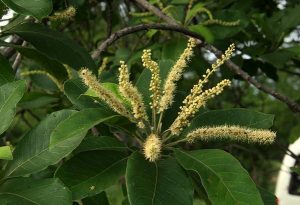
Terminalia stenostachya. Photo: Bart Wursten. Source: Flora of Zimbabwe.
Terminalia stenostachya. Flacourtia indica gave us another example of its many variant forms – it has variable flowers, is sometimes spiny, sometimes the leaves are hairy, etc. This specimen was in fruit and we were reliably informed that it was this species, also known as the Governor’s Plum, which gave Plumtree its name.
Would anyone who was not present believe me if I wrote that the Tree Society members walked about a kilometre down a path through a woody area with hardly a stop to look at a tree?! Maybe it was just that we all knew that Parinari capensis is the species which crawls on the floor while Parinari curatellifolia grows into a tree (Mobola plum); that there was a Khaya, there a Bauhinia petersiana in flower, over here an Antidesma in fruit (ear-ring tree); that we can all tell the different Acacias apart, know Carissa edulis and realise that we can tell Vangueria from Vangueriopsis because “Vangueria is hairier”. Probably, however, it was because we had been promised great things by the du Plessis family if we would push on to The River.
How right they were. Young Bequaertiodendron magalismontanum hung their uniquely obovate leaves over the cool water of the pool surrounded by Croton gratissimus. Sesbania flung their branch lets out of the gurgling brook and must have wondered whether all the discussion about whether the Pterocarpus rotundifolius was sub¬species rotundifolius (how could it be with those smaller, more numerous leaflets in my inexpert opinion?) or subspecies polyanthus var. martinii was worth distracting one’s attention from the scenic surroundings.
Then we were told that in fact this was not The River – only a stream. Through a barbed wire fence into the neighbour’s land and down the hill and we’ll soon reach The River proper. Keep moving Tree Soc. – stop pausing to look at the Catunaregam spinosa – we’ve seen it before and have been told it is a sign of previously degraded areas. Leave the Strychnos innocua alone with its 3- to 5-veined leaves and powdery bark alone. Yes that is Monotes glaber, the two Dalbergia and Pavetta but we must push on to The River. No, this is just another stream; The River is just over the ridge on the other side. It was hard deciding whether Andy or the dog was hottest – both seemed to want to go for a swim in the stream. However, as we waited for Ann and Maureen to catch us up it gave Michael Kimberley a chance to point out some orchids in flower in the shade on a rocky outcrop. He was further in his element as we passed through the aloe garden speckled with Euphorbia matabelensis and other Euphorbia species at the top and were able to gaze down onto The River – cutting through the landscape in spite of the many boulders which Nature had thrown in its path. Regrettably, having finally reached The River, the stomach grumbled and the head ached and so I decided to head back for the farmhouse. If only Andy had known that instead of wandering off with the rest he wouldn’t have had to beat the bush later trying to find me!
Ah! Lunch in the shade on the comfy green grass – a chat, a draught of finest farm-fresh lemonade, an opportunity to “take what you want” from the du Plessis’s nursery of indigenous trees (Klara and I did well as we loaded up the car leaving only enough room for the driver and passenger – we are now selling indigenous trees for $50 each from our back garden, 15 Tsotsi Way, Harare). I wish I could do justice to the lovely walk (even if it was a bit more strenuous than normal – just what we needed) and the du Plessis’s hospitality. A wonderful outing.
-Douglas Ball.
REPORT ON THE VISIT TO CHIPANGALI WILDLIFE ORPHANAGE BY MATABELELAND BRANCH MEMBERS
We had been asked to visit Chipangali with a view to discussing the Tree Society’s involvement in the possible establishment of an indigenous tree lot at Chipangali. On arrival at Chipangali at about 9 a.m., we found that there was no one there to meet us. Thinking that they were late, or that we were perhaps early some of us amused ourselves by wandering around looking at some of the animals in their cages. One of our members was obviously in favour or disfavour (?) with one of the big cats, since she was christened by being sprayed by the leopard!!
As we were making our way through the cage area a very agitated African lady was jumping up and down insisting that we must pay to get in. Your chairman went to investigate and on explaining that we had not come to look at the animals or to adopt one of them, he was directed to the office. The young lady there expressed surprise that we had come on the Sunday; she had been expecting us on the Saturday!! This seems to be the general rule in Zimbabwe these days, don’t expect that just because you made arrangements for a meeting on a particular day, that your arrangement will be kept).
Anyway we explained what we had come for, and the young lady pointed out the area for the proposed woodlot. Kevin Wilson, the son of Viv Wilson was not available, but would be coming later we were told.
We spent the next hour or so looking at the woodlot area to get an idea of which trees would be suitable for planting there.
The following species had managed to survive the disturbance in the area: ¬ Acacia gerrardii, Acacia karroo, Combretum imberbe, Combretum molle, Commiphora schimperi, Crocoxylon transvaalense, Dichrostachys cinerea, Diospyros lycioides, Diplorhynchus condylocarpon, Dombeya rotundifolia, Ehretia rigida, Euclea divinorum, Flacourtia indica, Flueggea virosa, Lannea discolor, Maytenus heterophylla, Maytenus senegalensis, Ormocarpum trichocarpum, Peltophorum africanum, Piliostigma thonningii, Rhus lancea, Rhus pyroides, Steganotaenia araliacea, Terminalia trichopoda Terminalia stenostachya, Turraea nilotica, Zanthoxylum capense, Zanthoxylum chalybeum, and Ziziphus mucronata.
An interesting find was Ziziphus zeyheriana the dwarf Ziziphus. Other notable small fry were Rhoicissus tridentata, Aloe zebrina in full flower, Combretum platypetalum, Annona stenophylla and Tylosema fassoglensis.
Your chairman had a nasty experience when we were making our way back to the car park. Not moving at our usual slow pace through the bush, he brushed against a tree containing a wasp or hornets next. The little devils warned him off with several stings on his left hand and his cheek. Fortunately he only had a few days with a swollen hand.
On reaching the car park we were told that Kevin Wilson had returned from town and was available in the laboratory.
Your chairman had a talk with Kevin during which he suggested that we make a project of Chipangali by helping them name and label the trees in the animal area so as to increase visitors’ awareness of trees and other plants in relation to animals. Perhaps, he said, if members of the Tree Society were seen labelling trees in the area we might get some inquiries from visitors about what we are doing and what the Tree Society in general does. Even if the general public does not notice the tree and other plant labels those amongst them who do have the interest will appreciate knowing which type or species of plant they are seeing.
Your chairman undertook to help name the indigenous trees in the area at a time that would be mutually convenient. Once all the trees had been named and a list made of the trees and their positions, a number of volunteers (who have already indicated their willing¬ness) will go out over a period of time and help to put up the labels for Chipangali.
As far as the Tree Society, or certainly your chairman is concerned, there are far too many exotics planted in the animal and cage area. It would perhaps be better to plant only those trees that are indigenous to that part of Bulawayo. There would certainly be many species to choose from. Perhaps Chipangali can be persuaded to gradually replace the exotics with indigenous species. We can only hope!
Kevin certainly came across as very enthusiastic, and keen on growing trees (as many as possible of anything he can find), and is prepared to take on extra projects and work. We left it up to him to make contact again about a date to go out and identify trees.
-Anthon Ellert.
BOTANIC GARDEN WALK: 3 MARCH 1998
The seemingly inexhaustible subject of lowveld trees continued this month in the beautiful Botanic Gardens.
Firstly, some Euphorbiaceae. We hurried past Antidesma venosum, the tassel-berry, which is a fairly common shrub often by rivers at low and medium altitudes. The flowers and fruits occur in pendulous spikes and the fruits are a red or dark purple colour.
Not very far away the large 3-lobed fruits of Excoecaria bussei, the pawnbroker tree, caught our eye. It has milky latex, which is unusual for Euphorbiaceae outside the genus Euphorbia; alternate leaves and occurs commonly in riverine vegetation. On opening a fruit we found 3 quite large spherical seeds. The only other species in this genus in Zimbabwe is Excoecaria madagascariensis, a rare tree in Zimbabwe occurring in the Chirinda Forest. This species has opposite leaves, an unusual characteristic in Euphorbiaceae and very surprising in a genus in which there are other species with alternate leaves.
Tom called our attention to the remarkable peeling bark of Euphorbia espinosa. Above it is silvery-grey while below the peel, at least on this specimen, the underbark was more or less dark red. He also mentioned the remarkable variation in life form in Euphorbia from annual herbs to shrubs and tree-sized cactus-like plants. Euphorbia espinosa is a shrub or small tree. As the name suggests it lacks spines.
Three species of Sterculia were examined. Two were reasonably familiar, namely:
Sterculia africana and Sterculia quinqueloba. Both species have a distinctive smooth peeling pale bark. These two can briefly be separated by the fact that africana has relatively small leaves and large fruits whereas quinqueloba has large leaves and small fruits. Sterculia quinqueloba occurs on rocky hills at low altitudes.
Sterculia appendiculata is one of the rarest trees in Zimbabwe. A few trees only have been found by the Mazowe River. Its leaves are intermediate in size between africana and quinqueloba. Outside Zimbabwe it grows in Malawi, Mozambique and Tanzania and may attain heights of 50 metres.
The fourth Zimbabwean Sterculia is the distinctive Sterculia rogersii, a small tree with a swollen trunk and rather small leaves. This occurs at low altitudes in the SE lowveld.
From the same family (Sterculiaceae) comes Triplochiton zambesiacus, a large tree from the Zambezi Valley. Tom noted that this has a perplexing ecology, occurring mainly in riverine vegetation but also in Jesse and on anthills. The fruit is winged and furry and is said to resemble a moth.
Finally, Tom showed us growing side by side the two species of Guibourtia, namely Guibourtia coleosperma and Guibourtia conjugata, sometimes known as the large and small false mopane respectively. Guibourtia belongs to the sub¬family Caesalpinioideae of the Leguminosae and the leaves are paired, somewhat similar to mopane. Both trees were in leaf only with no flowers or fruit and at first sight both looked rather similar. However, coleosperma has a more prominent midrib and its leaves are more curved. Had we had fruits, we would also have seen the striking scarlet aril on the seed of coleosperma (absent in conjugata).
Once again, our thanks to Tom for a most interesting evening.
-Mark Hyde
CROWNED HEADS OF THE AFRICAN DESERT
What makes the kokerboom particularly remarkable is its ability to thrive in the most barren regions of southwest Africa – where no other tree can tolerate the hostile habitat. The Aloe dichotoma, or kokerboom, can be over 1m in diameter at ground level, its tough smooth trunk gradually narrowing as it grows to reach a height of 7m halfway up, the trunk forks into two branches, each branch then dividing yet again and so on – a rare feature among flowering plants. The tips of the branches finally develop rosettes of foliage. Through this pattern of recurring subdivision, the crown of the tree develops a distinctive dome shape.
The greyish-green halo of the foliage is slashed with bright yellow patches in June and July, when the nectar-rich flowers appear and the insects and birds come swarming around. Baboons are fond of kokerboom trees and have been known to strip them bare.
Although the tree appears tall and strong from a distance, closer inspection often reveals a spindly, peeling trunk that is streaked with white. The clubfoot is locked into the rocky ground with thin, fibrous roots. Nevertheless, a kokerboom will often survive in its wilderness site for 100 years or more, absorbing water from the sea mists that envelop it at night. Local Hottentots and Bushmen have traditionally used the branches to make holders for their arrows and have given it the name ‘quiver tree’.
This extract is taken from Natures Masterpieces – Published by Readers’ Digest and is acknowledged with thanks
ANDY MACNAUGHTAN CHAIRMAN


